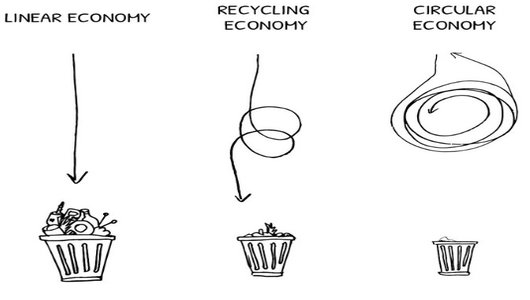Circular Economy
Constructing Excellence in Wales has been working to explore the opportunity for the built environment sector from circular economy. As the biggest consumer of raw materials the opportunity is significant, approximately £1 billion by 2035.
Circular Economy
The concept of a circular economy was inspired by the functioning of natural ecosystems where “nothing is lost and everything transformed”. It is a development strategy that enables economic growth while optimising consumption and resources. The circular economy is one that is restorative and regenerative by design and aims to keep products, components and materials at their highest utility and value at all times. It aims to decouple economic development from resource consumption, whilst enabling key policy objectives such as generating economic growth, creating jobs, and reducing environmental impacts, including carbon emissions. The model demonstrates how the principles of the circular economy can be applied to the sector to realise the potential benefits turning theory in practical application.
Definition of Circular Economy
Circular economy represents a development strategy that enables economic growth while optimising consumption of resources, deeply transforms production chains and consumption patterns, and redesigns industrial systems at the system level.
The circular economy aims to keep the value added in products for as long as possible and to cut residual waste close to zero. It could therefore be considered as a regenerative system, which retains the resources within the economy in contrast to the currently prevailing 'linear' model of extraction, manufacturing, consumption and disposal.
Moving to a circular economy requires changes in all parts of the value-chain, from consumer demand, through product design, new business models and new ways of turning waste into a resource. It implies a fully systemic change, affecting all stakeholders in the value chain.
Innovation, in all its forms – technological, organisational, and social – is one of the main drivers of the circular economy. A circular economy closes 'resource loops' in all economic activities in a sense that there is no 'end' within a circular economy, but a 'reconnection to the top of the chain and to various activity nodes in between'.
Circular Economy & Built Environment
A circular approach has been demonstrated to offer multiple benefits, these include warding against increasing material prices, conserving embodied carbon and adding value to end of life.
As the biggest consumer of raw materials (EEA, 2011), with eighty per cent of all materials produced used in the built environment, the scale of the opportunity for the sector is significant.
Download our reports on how the built environment can close the circle and implement circular economy principles. The reports have been developed as electronic documents, if printed please be aware that you will lose the electronic funtionally.
Download: Closing the circle Circular economy Opportunity for the welsh built environment Report
Download: Closing the circle Circular economy Opportunity for the welsh built environment Summary
CEW has developed two models and associated animations illustrating how the principles of circular economy can be applied to the built environment.
Download: Circular Economy Model Infographic - Construction Projects
Download: Economi Gylchol Model Ffeithlun - Cynlluniau adeiladu
Download: Circular Economy Model Animation - Construction Projects
Download: Economi Gylchol Model Animeiddio - Cynlluniau Adeiladu
Download: Circular Economy Model Infographics - Construction Phase
Download: Economi Gylchol Model Ffeithlun - Cyfnod Adeiladu
Download: Circular Economy for the Built Environment
Download: Economi Gylchol ar gyfer yr adeiladu amgylchedd
Download: Circular Economy - Construction Projects
Download: Economi Gylchol - Cynlluniau adeiladu
Economic Opportunity
Our research has demonstrated a potential economic opportunity of an additional £1 billion per annum by 2035. This is an increase of 12.5 per cent in the annual turnover of the Welsh built environment sector, and generating 7,300 jobs (gross). This figure is consistent with a growing body of research that identifies the economic opportunity and the importance of the sector in delivering. The built environment sector has a high environmental impact, retained financial value and potential for reuse.
Constructing Excellence in Wales is charged with improving the performance of the built environment sector. To achieve real improvement the sector will need to change, transitioning from being less bad to being good. In its role CEW will continue to identify opportunities, innovations and best practices key to delivering the best value built environment for Wales.
CEW has developed a model/animation detailing how the circular economy may be applied to the built environment. In addition, CEW have prepared a report highlighting the size of the economic opportunity, critical materials to prioritise and how the principles could be implemented across the sector to realise the benefit.
